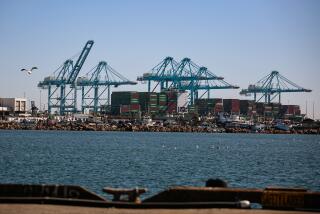Highway Accidents, Murders Top List of On-the-Job Deaths in ’92 : Workplace: Labor Department’s ‘milestone’ study finds logging and taxi driving are the most dangerous occupations.
- Share via
WASHINGTON — Highway accidents and murders were the leading causes of death for Americans at work in 1992, the Labor Department said Friday in the federal government’s first systematic tally of fatalities on the job.
The detailed study is “a true milestone” in producing better information on the dangers and risks of the workplace, said William G. Barron, commissioner of labor statistics. The study will now be conducted yearly.
Of the 6,083 fatalities last year, 1,121 occurred in highway accidents, and 1,004 were homicides, while the most deadly jobs in 1992 were logging and taxi driving, according to the Bureau of Labor Statistics.
For all Americans, the death rate on the job is five per 100,000 workers, but the toll soared to 142 per 100,000 for loggers, who work with the constant danger of being crushed by trees or mangled by equipment.
Taxi drivers, who died at a rate of 50 per 100,000, are also in grave danger on the job, as are those who work all night in convenience stores and gas stations, the study found. “Anybody that handles money and works alone becomes a target,” said Guy Toscano, program manager for the government’s new census of fatal occupational injuries. Police and fireman as a group died at a rate of 13 per 100,000.
Yet death in the workplace remains a relatively rare event in American life. In 1990, for example, 520 out of every 100,000 Americans died; of those, 32 were from accidents, 11 were from suicides and 10 were from homicides, according to the U.S. Department of Health and Human Services.
Of the 1,004 homicide victims killed on the job last year, the vast majority were killed by strangers. Only 48 were killed by co-workers, while another 20 were slain by their spouses. The vast majority of the cases were “killings by strangers, basically robberies,” according to Toscano.
The government traditionally reported on deaths and injuries in the manufacturing sector of the economy covered by the Occupational Safety and Health Act, but it did not include such occupations as railroad workers, farmers or the self-employed, Toscano said.
In an effort to be comprehensive, the new study includes all workers and draws on a range of sources, including death certificates, workers’ compensation reports, medical records and news reports.
“Multiple sources are used because studies have shown that no single source captures all on-the-job fatalities,” the Bureau of Labor Statistics said in its study.
The survey covers deaths resulting from traumatic occupational injuries: a wound or damage to the body caused by a specific event or incident on a single shift or working day. The focus is on deaths directly caused by something that happened at work on a particular day.
The past reports, limited to OSHA data, typically reported about 3,000 fatalities a year. The new figure of 6,083 deaths probably represents better reporting rather than a dramatic jump in death on the job.
Yet some job safety experts think the true figure could be higher because of injuries that do not prove fatal right away.
“If a worker is seriously injured on the job, he may go to a hospital trauma center and continue to live for a couple of days more, but when the doctors list the cause of death, they write down things like cardiac arrest,” said Joseph A. Kinney, executive director of the National Safe Workplace Institute in Chicago.
“The government just went from an F to a C- in its reporting,” said Kinney. “With this new report, they are getting better, but it’s a long way from having an accurate database. We still know far more about the slaughter of cattle in the U.S. on a daily basis than we know about the deaths of workers.”
After logging and taxi driving, the deadliest fields are construction work, farming and trucking. Some of the other common ways to die at work are falling, being struck by an object, being in a plane crash, being crushed by equipment and getting electrocuted.
The vast majority of those killed in 1992 were men: 5,657, or 93%. Among men, the most common cause of death was transportation accidents. For women, murder was the most frequent cause of death.
Among various racial and ethnic categories, 83% of those who died were white, 10% were black and 3% were Asian. Latinos accounted for 8% of victims.
Death at Work
The government’s first systematic census of fatalities on the job reported a total of 6,083 deaths in 1992. Here are the leading categories: Car and truck accidents on the highway: 1,121 Homicides: 1,004 Falls: 590 Struck by objects: 558 Vehicle accidents off the highways: 436 Aircraft accidents: 350 Electrocution: 334 Caught in or crushed by equipment: 312 Fires and explosions: 167 *
The Riskiest Jobs Industry: Deaths per 100,000 employees Forestry and logging: 142 Taxi drivers: 50 Construction: 34 Truckers: 25 Farming: 20 Source: Bureau of Labor Statistics
More to Read
Sign up for Essential California
The most important California stories and recommendations in your inbox every morning.
You may occasionally receive promotional content from the Los Angeles Times.













